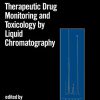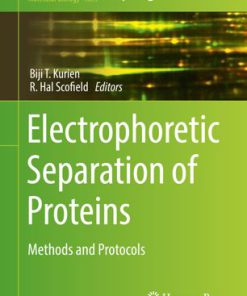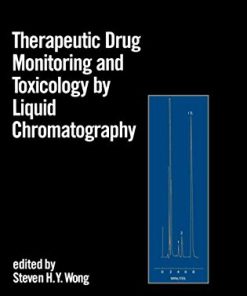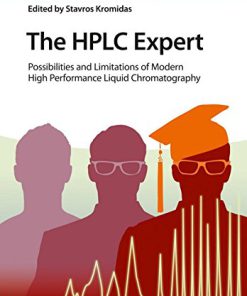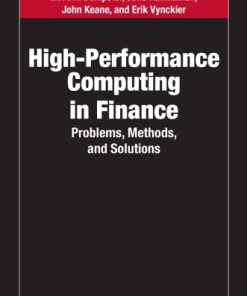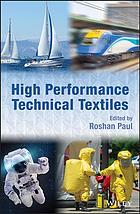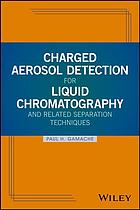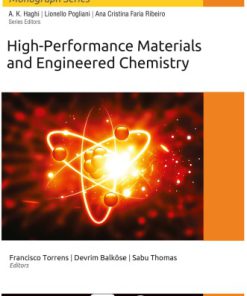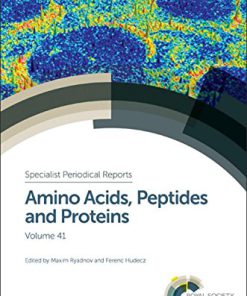High Performance Liquid Chromatography of Peptides and Proteins Separation Analysis and Conformation 1st Edition by Colin T Mant, Robert S Hodges ISBN 0367402963 978-0367402969
$50.00 Original price was: $50.00.$25.00Current price is: $25.00.
High-Performance Liquid Chromatography of Peptides and Proteins : Separation, Analysis, and Conformation 1st Edition by Colin T. Mant, Robert S. Hodges – Ebook PDF Instant Download/Delivery: 0367402963, 978-0367402969
Full download vHigh-Performance Liquid Chromatography of Peptides and Proteins : Separation, Analysis, and Conformation 1st Edition after payment
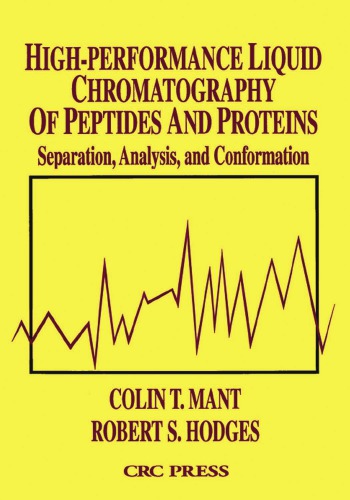
Product details:
ISBN 10: 0367402963
ISBN 13: 978-0367402969
Author: Colin T. Mant, Robert S. Hodges
This book consists of a series of 82 precise, easy-to-read articles by internationally renowned scientists and emphasizes the practical approach to HPLC with minimal theory, although the underlying principles for peptide and protein separations are clearly expressed. All of the major modes of microbore, ultrafast and analytical HPLC are discussed, including size-exclusion, ion-exchange, reversed-phase, hydrophobic interaction, and affinity and immunoaffinity chromatography. A section on preparative HPLC, including displacement techniques, is also presented. Problem-solving approaches to the separation of various classes of biologically active peptides and proteins are thoroughly explored, while the importance of peptide standards for monitoring column performance and for optimizing separation conditions is emphasized. Several articles focus on the choice of the correct detection method (electrochemical, UV, fluorescence), as well as the need for a proper knowledge of approaches to column and instrument maintenance and trouble-shooting. A section on predictive approaches deals with both computer simulation of peptide separations and peptide structure. The book also includes complementary techniques to HPLC, as well as other useful applications of HPLC. It enables both novice and experienced chromatographers to realize the full potential of this extremely powerful technique, in the process making an important contribution to scientific literature.
Table of contents:
Chapter 1: Properties of Peptides/Proteins and Practical Implications
Chapter 2: Standard Chromatographic Conditions for Size Exclusion, Ion-Exchange, Reversed-Phase and Hydrophobic Interaction Chromatography
Chapter 3: Preventive Maintenance and Troubleshooting LC Instrumentation
Chapter 4: Tools and Techniques to Extend LC Column Lifetimes
Chapter 5: Mobile Phase Preparation and Column Maintenance
Chapter 6: HPLC Guard Columns
Chapter 7: On-Line Derivatization of Silica Supports for Regeneration of Reversed-Phase Columns
Chapter 8: HPLC Terminology: Practical and Theoretical
Chapter 9: High-Performance Liquid Chromatography of Peptides and Proteins: General Principles and Basic Theory
Chapter 10: High-Performance Liquid Chromatography of Peptides and Proteins: Quantitative Relationships for Isocratic and Gradient Elution of Peptides and Proteins
Chapter 11: Requirement for Peptide Standards to Monitor Ideal and Non-Ideal Behavior in Size-Exclusion Chromatography
Chapter 12: High-Performance Size-Exclusion Chromatography of Proteins
Chapter 13: Size-Exclusion Chromatography of Proteins
Chapter 14: Size-Exclusion High-Performance Liquid Chromatography of Integral Membrane Proteins and the Effect of Detergents on Immunological Activity
Chapter 15: A Reversed-Phase Trace Enrichment Technique for the Loading of Size-Exclusion HPLC Columns
Chapter 16: The Use of Peptide Standards for Monitoring Ideal and Non-Ideal Behavior in Cation-Exchange Chromatography
Chapter 17: Ion-Exchange High-Performance Liquid Chromatography of Peptides
Chapter 18: Use of Ion-Exchange Cartridges for Batch Extraction in the Purification of Pituitary Peptides
Chapter 19: High-Performance Ion-Exchange Chromatography of Proteins
Chapter 20: High-Performance Ion-Exchange Chromatography of Proteins: Application to the Purification of Enzymes
Chapter 21: Anion Exchange High-Performance Liquid Chromatography of Viral Proteins
Chapter 22: Sample Preparation and Application of Different HPLC Methods for the Separation of Hydrophobic Membrane Proteins
Chapter 23: Cation-Exchange High-Performance Liquid Chromatography: Group Separation of Acidic and Basic Proteins Using Volatile Solvents
Chapter 24: Separation of Protein Isoforms: An Ion-Exchange HPLC Separation of Bovine and Cardiac Troponin Complexes
Chapter 25: Assessment of Steroid Receptor Polymorphism by High-Performance Ion-Exchange Chromatography
Chapter 26: Reversed-Phase Packings for the Separation of Peptides and Proteins by Means of Gradient Elution High-Performance Liquid Chromatography
Chapter 27: Commercially Available Columns and Packings for Reversed-Phase HPLC of Peptides and Proteins
Chapter 28: Requirement for Peptide Standards to Monitor Column Performance and the Effect of Column Dimensions, Organic Modifiers, and Temperature in Reversed-Phase Chromatography
Chapter 29: The Use of Peptide Standards to Monitor Non-Ideal Behavior Due to Underivatized Silanols in Reversed-Phase Chromatography
Chapter 30: The Effect of Varying Flow-Rate, Gradient-Rate, and Detection Wavelength on Peptide Elution Profiles in Reversed-Phase Chromatography
Chapter 31: Manipulation of pH and Ion-Pairing Reagents to Maximize the Performance of Reversed-Phase Columns
Chapter 32: The Effects of Anionic Ion-Pairing Reagents on Peptide Retention in Reversed-Phase Chromatography
Chapter 33: The Biological Activity of Polypeptides After Reversed-Phase High-Performance Chromatography: A Comparative Study
Chapter 34: Reversed-Phase Chromatography of Insulin and Iodinated Insulin
Chapter 35: Batch-Extraction of Human Pituitary Peptides on a Reversed-Phase Matrix: Application to the Purification of the POMC-Joining Peptide
Chapter 36: Automated Determination of Amino Acid Enantiomers Using Derivatization with 1-(9-Fluorenyl)Ethyl Chloroformate and Reversed-Phase Liquid Chromatography
Chapter 37: Reversed-Phase High-Performance Liquid Chromatography for the Separation of Peptide Diastereoisomers
Chapter 38: Separation of Intrachain Disulfide Bridged Peptides from Their Reduced Forms by Reversed-Phase Chromatography
Chapter 39: Chromatography of Proteins at High Organic Solvent Concentrations: An Inverse-Gradient Reversed-Phase HPLC Method for Preparing Samples for Microsequence Analysis
Chapter 40: Discontinuous Reversed-Phase Chromatography: A Separation Method for Complex Protein Mixtures Applicable in Both Analytical and Large Scale High-Performance Liquid Chromatography
Chapter 41: Hydrophobic Interaction Chromatography of Proteins
Chapter 42: Effects of HPLC Solvents and Hydrophobic Matrices on Denaturation of Proteins
Chapter 43: High-Performance Hydrophobic Interaction Chromatography of a Labile Regulatory Protein
Chapter 44: High-Performance Affinity Chromatography of Peptides and Proteins
Chapter 45: HPLC Purification of Plasma Serine Proteinases: Application to Plasma Kallikrein and Factor XII
Chapter 46: The Use of Heparin Affinity High-Performance Liquid Chromatography for the Isolation and Characterization of Fibroblast Growth Factors
Chapter 47: Theory and Practical Aspects of High-Performance Immunoaffinity Chromatography
Chapter 48: Isolation and Measurement of Membrane Proteins by High-Performance Immunoaffinity Chromatography
Chapter 49: Packing Liquid-Chromatography Columns
Chapter 50: Packing Columns in the Microbore to Semi-Preparative Range
Chapter 51: The Practical Application of Diode Array UV-Visible Detectors to High-Performance Liquid Chromatography Analysis of Peptides and Proteins
Chapter 52: Peak Identification in HPLC of Peptides Using Spectral Analysis and Second Order Spectroscopy of Aromatic Amino Acid Residues
Chapter 53: Detection Alternatives for HPLC Analysis of LHRH and LHRH Analogs
Chapter 54: Post Column Reaction Systems for Fluorescence Detection of Polypeptides
Chapter 55: HPLC Analysis of Protein Folding
Chapter 56: Analysis of Protein Folding by Size-Exclusion Chromatography
Chapter 57: Complementary Application of Size-Exclusion Chromatography and Circular Dichroism to the Study of Protein Folding
Chapter 58: On-Line Conformational Monitoring of Proteins in HPLC
Chapter 59: Reversed-Phase HPLC Separation of Homologous Proteins: Interleukin-2 Muteins
Chapter 60: Reversed-Phase Chromatography: The Effect of Induced Conformations on Peptide Retention
Chapter 61: The Effect of Hydrophobic Residue Distribution in α-Helical Peptides on Peptide Retention Behavior in Reversed-Phase HPLC
Chapter 62: Micro-HPLC Techniques for the Purification and Analysis of Peptides and Proteins
Chapter 63: Reversed-Phase HPLC Separation of Sub-Nanomole Amounts of Peptides Obtained from Enzymatic Digests
Chapter 64: Comparison of Peptide Resolution on Conventional, Narrowbore, and Microbore Reversed-Phase Columns
Chapter 65: Rapid HPLC of Peptides and Proteins
Chapter 66: Ultrafast HPLC for Protein Analysis
Chapter 67: Development and Application of a Computer Simulation Program for Method Development and Teaching in HPLC: Prodigest-LC
Chapter 68: Computer Simulation as a Tool for Optimizing Gradient Separations
Chapter 69: HPLC Hydrophobicity Parameters: Prediction of Surface and Interior Regions in Proteins
Chapter 70: Practical Aspects of Preparative Reversed-Phase Chromatography of Synthetic Peptides
Chapter 71: Purification of Histidine-Rich Hydrophilic Peptides
Chapter 72: Preparative Reversed-Phase Gradient Elution Chromatography on Analytical Columns
Chapter 73: Preparative Reversed-Phase Shallow Gradient Approach to the Purification of Closely-Related Peptide Analogs on Analytical Instrumentation
Chapter 74: Preparative Reversed-Phase Sample Displacement Chromatography of Synthetic Peptides
Chapter 75: Displacement Chromatography of Peptides and Proteins
Chapter 76: Practical Considerations for Assessing Product Quality of Biosynthetic Proteins by HPLC
Chapter 77: Protein and Peptide Mapping by Two-Dimensional High-Performance Liquid Chromatography
Chapter 78: Amino Acid Analyses of Proteins and Peptides: An Overview
Chapter 79: Beckman System 6300 High-Performance Amino Acid Analyzer
Chapter 80: Pharmacia/LKB Amino Acid Analyzer Systems Using Pre-Column or Post-Column Derivatization
Chapter 81: Protein and Peptide Sequencing by Automated Edman Degradation
Chapter 82: Analysis of Proteins and Peptides by Free Solution Capillary Electrophoresis (CE)
People also search for:
ultra high performance liquid chromatography
reverse phase high performance liquid chromatography
how does high performance liquid chromatography work
types of high performance liquid chromatography
ultra high performance liquid chromatography slideshare
Tags: Colin T Mant, Robert S Hodges, High Performance Liquid Chromatography, Peptides, Proteins, Separation, Analysis, Conformation
You may also like…
Biology and other natural sciences
Electrophoretic Separation of Proteins: Methods and Protocols Biji T. Kurien
Chemistry - Analytical Chemistry
Science (General)
High-Performance Computing in Finance : Problems, Methods, and Solutions First Edition Dempster
Technique - Materials
Uncategorized
Cookbooks
Biology and other natural sciences



